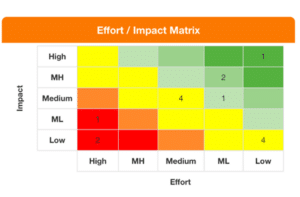KPI Fire has compiled 12 of the best practices for continuous improvement of the organizations that are thriving in this volatile and evolving business environment. None of them are waiting for the world to get back to normal. Instead, they are taking the opportunity to think strategically about what they’re up against and have focused on the ability to adapt very quickly to a changing environment. Most companies have embraced the opportunity to rethink their Continuous Improvement efforts and retool their overall operations.
Looking for Operational Excellence Success Stories?
1. Relentless Communication About Important Goals and Strategies.
As a leader of any company or function, one of the most important duties you can perform is to communicate the important goals and strategies for your team. As you are developing your Operational Excellence program you need to establish clear strategies and goals that can be easily interpreted by the organization.
At the highest levels, your goals might vary based on company strategy, but for most operational excellence programs you can start with these objectives: Reduce Waste, Eliminate Variation, and Prevent Overburden.
2. Capturing and validating benefits
Capturing and validating benefits are crucial aspects of continuous improvement. By systematically tracking and evaluating the outcomes of improvement initiatives, organizations can ensure tangible results in terms of cost reduction. Effectively managing a cost-savings portfolio involves:
-
Identifying and quantifying benefits: Clearly define and measure the anticipated benefits of each improvement initiative. This may involve establishing baseline metrics, setting targets, and tracking progress/or savings over time.
-
Implementing data collection methods: Establish mechanisms for collecting data relevant to the identified benefits. This may include surveys, interviews, performance reports, or financial data.
-
Analyzing data and validating results: Regularly analyze the collected data to assess whether the improvement initiative is achieving its intended benefits. This may involve statistical analysis, trend analysis, or root cause analysis.
-
Communicating benefits to stakeholders: Effectively communicate the captured and validated benefits to stakeholders, including senior management, employees, and customers. This can help to build support for continuous improvement efforts and demonstrate the value of these initiatives.
Capturing and validating benefits are not only essential for demonstrating the effectiveness of continuous improvement efforts but also for identifying opportunities for further improvement. By understanding the cost-savings achieved through improvement initiatives, organizations can prioritize investments and allocate resources more effectively. Additionally, capturing project benefits can help to identify areas where improvement efforts are falling short, allowing for targeted interventions and course correction.
3. Move the metrics that matter to your business
Every business has hundreds or thousands of data points. Focus on the KEY in Key Performance Indicators. Start with a few simple questions. If you understand which metrics are truly important in your business, you can start to move them in the right direction. One of the most important metrics to track as part of your Continuous Improvement program is cost savings or Total Benefit.
What is the best number that can represent our performance:
See these related articles:
“How to Track Project Benefits in a Cost Savings Portfolio”
4. Capture Ideas for Improvement
When you first launch your Continuous Improvement program you might experience some blank stares or some sideways looks when you tell people that you are looking for ideas for improvement. Initially you might get some interesting ideas. While the success of your program might be measured by your most successful projects, you shouldn’t expect every idea to be a grand slam home run. Be careful not to alienate people who provide ideas that are not “up to your standard” or may not be the kind of project you are looking for. The early stages of building a Continuous Improvement program it is important to make people feel empowered to notice things that can be better, and to empower them to make small changes that can make their jobs easier, or what we referred to as “preventing overburden.”
5. Manage an Idea Funnel
One of the primary jobs of a leader is to “Say Yes to the few, and wait to the many.” Once you start to collect ideas in your Idea Funnel, you should end up with more ideas than your limited CI/OpEx Resources can handle. One of the best tools for determining which ideas should move forward is an Effort vs. Impact matrix.

6. Project Initiation is a critically important skill in an organization
If you want a project to be successful, getting it off to a good start is critical. Some things that should be done very early on in a project is to identify a Project Leader, a Project Sponsor, Create a Charter complete with a description of the Problem or Opportunity, and a Target outcome. The Leader and the Sponsor should get some early agreement about what needs to be done. The leader will take primary responsibility for pushing the project forward, and the Sponsor plays the role of clearing the path or removing obstacles when the Leader gets stuck.
7. The Weekly Review for Project Management
These reviews can be used to touch base with all of the people responsible for tasks in a project and to keep things moving forward. Meeting on a regular interval is a much better way to establish follow ups vs milestone based meetings. In milestone based meetings you might schedule a meeting after something is ready. With time interval based meetings, you might end up meeting again before the deliverable is ready, but at least you will have a chance to make sure it hasn’t been neglected. Remember, not every project is going to be completed. If a project is really not worth finishing, it is better to meet & make that decision & formally put the project on the shelf, than to have it consume mental energy.
8. Develop a Best Practice Library
A Best Practice Library is a collection of Project Templates and other tools that can be used by your team to expedite the work of an improvement project. These can include Project Templates, Charter Templates, Report Templates, 5 Whys templates, SIPOC , Voice of Customer Value Stream maps.
(refer to link for House of Lean for further details about tools)
9. Track Improvement Projects
If you want a sustainable Operational Excellence program accountability is critical. You need to track the benefits and the costs of your improvement projects. Some projects might be harder to get exact numbers, but don’t let that stop you. You might find that the finance team will have some interest in sharpening their pencil on your numbers. This is a good thing if the finance department will get involved in this project accountability.
10. Summarize the project data and share it with the organization
Nothing breeds success like success. If you can show some successful projects you are likely to get more support, and more ideas for more projects.
11. Have a People Continuous Improvement Program
A healthy Continuous Improvement Program can be a great way to partner with the Human Resources department in creating a career path. The best employees are the ones who want to grow and improve themselves. Show them how they can increase their earning potential and their value to the company by getting involved with improvement projects. Every company needs more people who are inspired to make things better.
12. Practice “Teach and Train”
Teach and Train new employees on the tools of the Continuous Improvement discipline. If you don’t have a green belt training program, you might want to develop one. Or you can hire a consultant to come in and help you get started. Training people with a common set of problem solving skills is exactly what you need to develop leaders in your organization.
13. Align Projects With the Right People
Match people with projects that will capture their own interests AND make the business better. If you are a highly skilled and very experienced OpEX professional you might not have time for smaller projects. This funnel of newly trained employees is a great way to increase your throughput for Improvement Projects.


